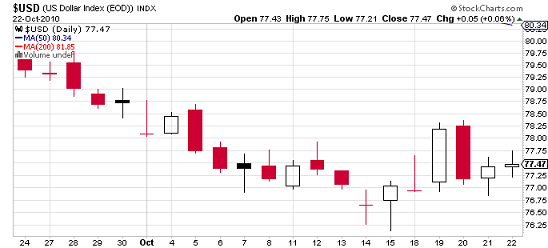I’m back in the office after last week’s
Wyatt Investment
Research company retreat. I wish I could say it was
three days of relaxing fun in the Vermont mountains, but the truth is, it
was three days of non-stop meetings and presentations.
At least we ate well…
However, I’m sure our meetings were more productive than
the G20 meeting in Gyeongju, South Korea over the weekend. This is the
second time the G20 has gotten together to chat in the last few weeks.
And the only thing they can agree on is that the IMF needs to do
something.
OK, G20 countries also agreed to “…refrain from
competitive devaluations…” of their currencies. Unless you’re the U.S.
Federal Reserve, of course. There should be no doubt that the Fed’s
expected monetary easing is a form of currency devaluation.
Interestingly, though, the subtext of the G20 meeting
wasn’t the Fed’s anticipated actions, it was China and the value of its
currency, the yuan.
And it was Treasury Secretary Tim Geithner leading the
rhetorical charge.
Due to cheap
labor, China has become the world’s factory. And that means that China
now runs a massive trade surplus. Many countries, including the U.S.,
have concluded that China helps maintain its cost advantage and trade
surplus by keeping the yuan undervalued.
In an interview with Bloomberg TV, Geithner acknowledged
that countries with more flexible exchange rates are “under a lot of
pressure” to maintain growth and stability.
“That pressure is magnified because some countries are
still limiting the appreciation of their currency. And that’s unfair,”
Geithner said.
Would there be a rejuvenation of U.S. manufacturing if
China allowed the yuan’s value to be defined by currency markets? No, at
least no time soon. But there would be a change in the amount of new
investment money that flows into China.
We saw a big
drop on the S&P 500 last Tuesday. And Deutsche Bank (NYSE:DB)
reported that 30% of short dollar positions were covered last Monday.
That’s an absolutely huge amount of short covering.
And you can see the result clearly on this chart of the
U.S. dollar vs. the euro (USD)…

 Facebook
Facebook
 Twitter
Twitter